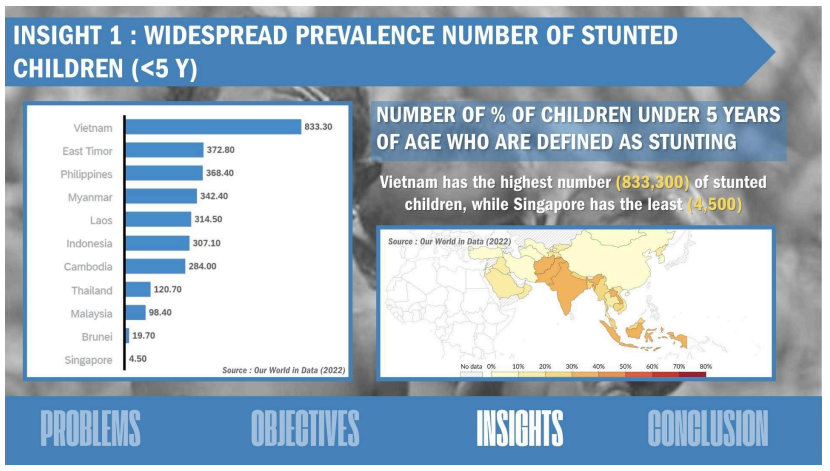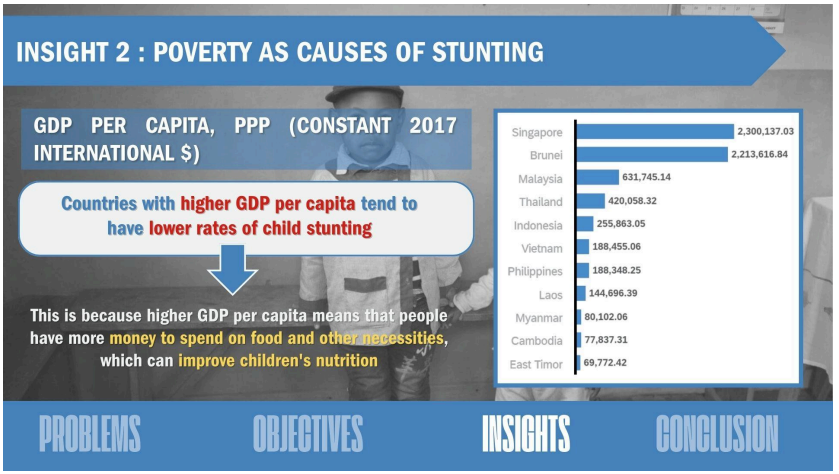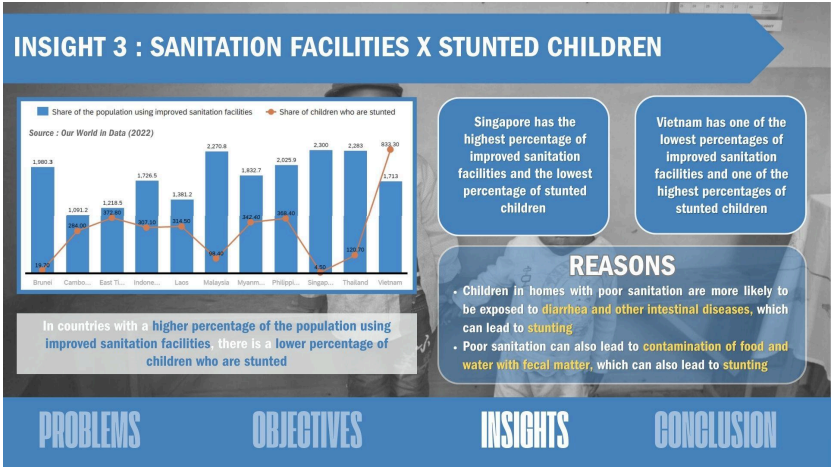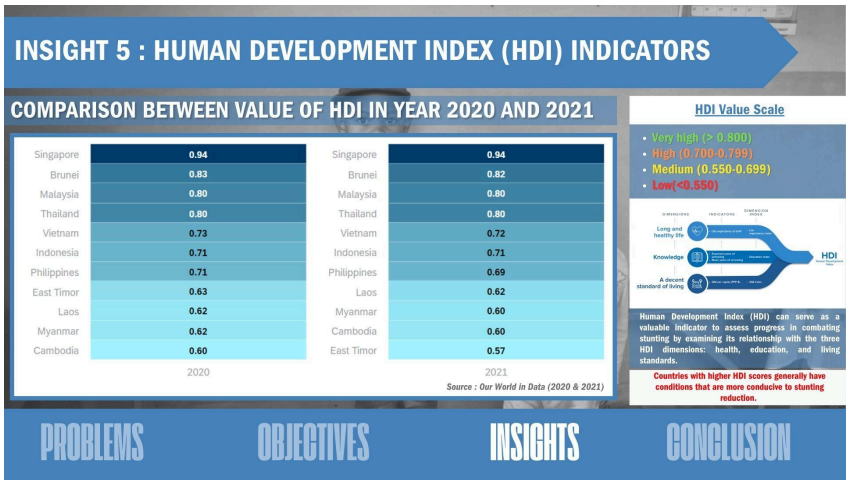A Life Less Lived: How Stunting Limits Potential and Steals Futures
Abstract—Stunting remains a critical public health challenge that directly impacts Sustainable Development Goals (SDGs) 2 (Zero Hunger) and 3 (Good Health and Well-being) within ASEAN nations. This article explores the multifaceted consequences of stunting on physical growth, cognitive development, and long-term health outcomes. By addressing these root causes, ASEAN countries can make significant strides towards achieving SDGs 2 and SDGs 3, ensuring that all children have the opportunity to live healthier, more productive lives. The findings highlight the importance of targeted interventions and policies that promote equitable access to resources, ultimately fostering sustainable development and well-being across the region. We use SAP analytics cloud software as a statistical data processing tool in this storyboard.
Introduction
Stunting is a significant global public health concern, affecting approximately 280 million children under five years old worldwide. It is especially prevalent in developing countries and among marginalized populations. Stunting has severe consequences, including impaired physical growth, cognitive development, and an increased risk of chronic diseases. These issues contribute to reduced productivity, lower earning potential, and increased healthcare costs. The problem is further exacerbated by disparities and inequalities, particularly among children from low-income households, rural areas, and marginalized communities. This cycle of poverty perpetuates stunting and its associated effects, hindering societal progress.
Problems Definition
A. Widespread Prevalence
Stunting affects an estimated 280 million children under five globally, making it a critical public health issue. Developing countries, especially those in sub-Saharan Africa and South Asia, report the highest prevalence rates. Factors contributing to stunting include poor maternal health and nutrition, inadequate infant and young child feeding practices, and frequent infections. These conditions are often exacerbated by limited access to healthcare, clean water, and sanitation, which are vital for healthy growth and development.
B. Disparities and Inequality
Stunting is disproportionately concentrated among children from low-income households, rural areas, and marginalized communities. This disparity exacerbates existing inequalities and perpetuates the cycle of poverty. Children in these groups often have less access to nutritious food, healthcare, and education, all of which are crucial for proper growth and development. Addressing stunting requires targeted interventions to reach these vulnerable populations, ensuring they receive adequate nutrition, healthcare, and support.
Objectives
To address the pervasive issue of stunting and its profound impact on childhood development and future potential, it is crucial to develop and implement comprehensive policies and initiatives across the ASEAN region. These strategies should aim to eradicate stunting by improving early childhood development and tackling root causes such as poverty and food insecurity. By focusing on enhancing maternal nutrition, promoting adequate infant and young child feeding practices, and ensuring access to healthcare, clean water, and sanitation, these initiatives can create a robust support system for vulnerable populations. Additionally, policies should target socioeconomic disparities by providing resources and support to low-income households and marginalized communities. Through these concerted efforts, ASEAN nations can ensure that all children have the opportunity to reach their maximum potential, thereby fostering a healthier, more equitable, and prosperous future for the region.
Insights
Insight 1 : Widespread Prevalence Number of Stunted Children (<5 Y)

This insight shows the widespread prevalence of stunted children under five years old. The data presented is the percentage of children under five who are defined as being affected by stunting in ASEAN countries. From this data taken from the source Our World in Data in 2022, Vietnam is the country with the highest stunted rate, reaching 833.30, while Singapore is the country with the lowest stunted rate, with a rate of 4.50.
Insight 2 : Poverty as Causes of Stunting

This insight shows poverty as a cause of stunting. The data are GDP per capita figures in constant 2017 international $ in ASEAN countries. From this data, Singapore has the highest GDP per capita. Countries with higher GDP per capita tend to have lower rates of child stunting. This is because higher GDP per capita means that people have more money to spend on food and other necessities, which can improve children’s nutrition. If we connect it with the first insight, Singapore has the highest GDP per capita and the lowest stunting rate.
Insight 3 : Sanitation Facilities X Stunted Children

This insight displays Sanitation Facilities and Stunted Children. The data presented are population figures using improved welfare facilities, and the share of children stunted in ASEAN countries. In countries with a higher percentage of the population using improved sanitation facilities, there is a lower percentage of stunted children. The reason is that Children in homes with poor sanitation are more likely to be exposed to diarrhea and other intestinal diseases, which can lead to stunting. Poor sanitation can also lead to contamination of food and water with fecal matter, which can also lead to stunting. From this data, Singapore has the highest percentage of improved sanitation facilities and the lowest percentage of stunted children.
Insight 4 : Food Insecurity

This insight shows food insecurity. The data presented are population figures with severe food insecurity in ASEAN countries. Food insecurity is a significant factor contributing to child stunting in Southeast Asia. Addressing food insecurity through measures like improving agricultural productivity, social safety nets, and access to markets for small-scale farmers is likely essential to reducing stunting
rates in the region. When a household experiences food insecurity, it means they lack consistent access to sufficient, affordable, nutritious food, which leads to child stunting. Cambodia has The highest severe food insecurity (51.1%), while INDONESIA (4.9%) has the lowest percentage.
Insight 5 : Human Development Index (HDI) Indicators

This insight presents the Human Development Index (HDI) indicators comparing the values of HDI in 2020 and 2021 in ASEAN countries. The Human Development Index (HDI) is a valuable indicator for assessing progress in combating stunting by examining its relationship with the three HDI dimensions: health, education, and living standards. Generally, countries with higher HDI scores have conditions more conducive to reducing stunting.
Solutions
a) Enhancing Food Security and Nutrition
To enhance food security and nutrition, we should boost nutritious food production through sustainable agriculture, improve food distribution especially to remote areas, and promote family farming and home gardens for increased food availability at the household level.
b) Improving Access to Clean Water and Sanitation
Ensuring universal access to clean water and sanitation is crucial for preventing stunting. Investing in water infrastructure and promoting hygiene prevents diseases and improves child health.
c) Improving Access to Healthcare Services
To prevent stunting, improve access to quality antenatal, delivery, and postnatal services; ensure high coverage of routine immunizations; implement regular deworming and micronutrient supplementation programs.
d) Enhancing Education and Advocacy
To combat stunting effectively, implement education and advocacy programs that foster public awareness and drive community action. Encourage good parenting practices to create a nurturing environment for children’s growth. Finally, involve civil society, NGOs, and the private sector to collaborate and amplify the impact of anti-stunting initiatives.
e) Strengthening Government Policies and Programs
To combat stunting effectively, governments should establish comprehensive national policies, allocate sufficient budgets, and ensure robust coordination between involved ministries. Regular monitoring and evaluation are vital to measure progress and adapt strategies as needed.
Tackling stunting requires sustained and collaborative efforts from various stakeholders. By implementing these practical solutions, we can create an environment conducive to optimal child growth and development, build a healthier and smarter generation, and pave the way for a brighter future for all.
Conclusion
Stunting is a pervasive issue within ASEAN countries that drastically affects children’s physical growth, cognitive development, and long-term health outcomes. By deeply analyzing the situation, it has become evident that stunting is not merely a health issue but a multifaceted problem deeply rooted in socioeconomic inequalities, inadequate nutrition, and lack of access to essential services like healthcare and clean sanitation. The insights gathered from the analysis highlight the critical relationships between poverty, GDP per capita, sanitation facilities, and stunting rates, indicating clear paths for targeted intervention.
Firstly, the higher GDP per capita in countries like Singapore correlated with lower stunting rates, suggesting that economic prosperity is paramount in providing the resources needed for nutrition and healthcare. Secondly, the focus on disparities and inequality sheds light on the necessity of reaching marginalized communities to break the cycle of poverty and stunting. Lastly, the data on sanitation facilities underscores the importance of basic infrastructure in preventing infections that contribute to stunting.
To combat stunting effectively, ASEAN nations must implement comprehensive, multi-sectoral strategies that address these root causes. Policies aimed at improving economic conditions, ensuring equitable access to nutritious food and healthcare, and upgrading sanitation infrastructure are essential steps toward eradication. Moreover, targeted interventions must prioritize the most vulnerable populations to close the gap in disparities. Achieving Sustainable Development Goals 2 (Zero Hunger) and 3 (Good Health and Well-being) hinges on collective efforts to address and eliminate stunting. With exemplary commitment and actions, ASEAN can ensure that all children have the foundation for healthier and more productive lives, laying the groundwork for sustainable development and prosperity in the region.
reference :
- https://ourworldindata.org/food-insecurity
- https://ourworldindata.org/hunger-and-undernourishment
- https://hdr.undp.org/data-center/human-development-index#/indicies/HDI
- https://ourworldindata.org/grapher/human-development-index
- https://ourworldindata.org/grapher/stunting-vs-level-of-prosperity-over-time?tab=table
- https://ourworldindata.org/stunting-definition Prevalence of stunting vs. improved sanitation facilities, 2022 (ourworldindata.org)
Causes of Death – Our World in Data Poverty – Our World in Data

